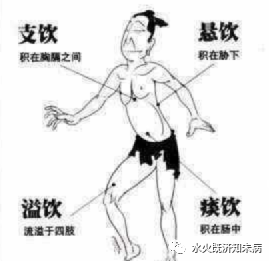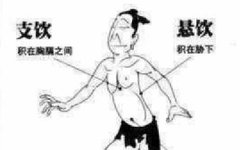
Due to the decline of the spleen’s ability to transform and transport water and dampness, or obstacles in the circulation and excretion of fluids within the body, water and fluids cannot nourish the body normally, leading to abnormal accumulation and the formation of a pathological substance. This abnormal accumulation of water and fluids is referred to in Traditional Chinese Medicine (TCM) as “Phlegm-Dampness” (痰饮, tán yǐn). The turbid, viscous, and thick portion is called “Phlegm” (痰, tán), while the clear, thin, and transparent portion is referred to as “Dampness” (饮, yǐn). Therefore, in TCM, the term “Phlegm” does not solely refer to the mucus produced in the lungs that can be expelled through coughing, which we can observe. TCM’s concept of “Phlegm” also includes pathological products resulting from fluid metabolism disorders that exhibit characteristics of turbidity, viscosity, and thickness. For instance, obesity is referred to as “Phlegm” in TCM. Since this type of “Phlegm” is not as easily recognized as the phlegm produced in the lungs, it is termed “Invisible Phlegm” (无形之痰, wú xíng zhī tán), while the phlegm produced in the lungs that can be expelled and seen is called “Visible Phlegm” (有形之痰, yǒu xíng zhī tán). Together, these two concepts form the TCM understanding of “Phlegm”.1.Visible Phlegm and Invisible Phlegm(1) “Visible Phlegm” primarily exists in the lungs and may arise from either internal fluid metabolism disorders or external pathogenic factors invading the lungs. This type of phlegm can be expelled through coughing and is observable, making it easier to understand. We are quite familiar with “Visible Phlegm,” as we often encounter it during colds and coughs. However, have we noticed that even the phlegm coughed up from the lungs can vary in characteristics? For example, some phlegm is white and viscous, some is white and thin, some is white and foamy, some is yellow and thick, some is grayish-black, and some is yellow-green.The thickness and color of phlegm are closely related to the body’s “Heat” (热, rè). When there is heat in the body, the phlegm is yellow and thick; when there is no heat, the phlegm is thin and white. The greater the thickness and yellowness, the higher the level of heat in the body. TCM categorizes phlegm that is white and thin, or foamy, or viscous as “Cold Phlegm” (寒痰, hán tán), while phlegm that is yellow and thick, or even yellow-green, is termed “Heat Phlegm” (热痰, rè tán). Since Cold Phlegm and Heat Phlegm reflect completely opposite natures, their treatments are also entirely different. To treat Cold Phlegm, warming and transforming methods are used, with common herbs including Gan Jiang (干姜, Dried Ginger), Xi Xin (细辛, Asarum), Jiang Ban Xia (姜半夏, Pinellia), Chen Pi (陈皮, Aged Tangerine Peel), Bai Jie Zi (白芥子, White Mustard Seed), and Lai Fu Zi (莱菔子, Radish Seed); while for Heat Phlegm, clearing heat and transforming phlegm methods are employed, with common herbs including Zhe Bei Mu (浙贝, Zhejiang Fritillaria), Chuan Bei Mu (川贝, Sichuan Fritillaria), Tian Zhu Huang (天竺黄, Bamboo Grass), Dan Nan Xing (胆南星, Arisaema), Gua Lou (瓜蒌, Trichosanthes), and Tian Hua Fen (天花粉, Trichosanthes Root). Regardless of whether it is Cold Phlegm or Heat Phlegm, TCM emphasizes the concept of “transformation” in treatment. The phlegm-transforming herbs used in TCM are akin to the action of “alum,” which can decompose and settle phlegm turbidity, thereby eliminating diseases caused by phlegm turbidity.(2) TCM identifies the presence of “Invisible Phlegm” in the body based on four criteria.1.Obesity. The TCM saying “fat people have more phlegm-dampness” refers to the presence of “Invisible Phlegm” in obese individuals, as fat possesses the characteristics of turbidity, viscosity, and thickness associated with phlegm. It is formed from the turbid portions of water and dampness accumulated in the body.2.Thick and greasy tongue coating. A thick and greasy tongue coating is the most direct manifestation of excessive water and dampness in the body.3.Masses. Any mass that is not red in color, protrudes from the skin surface, is nodular, and feels soft or resilient upon palpation is referred to in TCM as a “Phlegm Mass” (痰块, tán kuài). 4.Slippery pulse. TCM classifies pulse sensations into over twenty types based on different feelings under the fingers, with the slippery pulse being one of them. The description of a slippery pulse in TCM is “smooth and flowing, like pearls rolling on a plate,” indicating that the pulse feels as if beads are rolling smoothly on a plate. The presence of a slippery pulse is a characteristic manifestation of phlegm turbidity in the body and is one of the main diagnostic criteria for “Phlegm” in TCM.Western diseases such as hyperlipidemia, cysts, lymph node tuberculosis, and bone tuberculosis all exhibit characteristics of turbidity, viscosity, and thickness, and can therefore be considered phlegm-related diseases. In this way, Western medical examinations extend the TCM diagnostic methods of observation, listening, inquiry, and palpation. Through TCM’s understanding of the mechanisms of phlegm formation, we can relate the occurrence of these diseases to the overall balance of the body, finding fundamental treatment methods. For example, hyperlipidemia, cysts, and lymph node tuberculosis all align with the characteristics of TCM phlegm, and their root causes are related to the spleen’s dysfunction in transformation and transportation, leading to excessive accumulation of water, dampness, and phlegm in the body. Therefore, treatments can be applied to strengthen the spleen, assist in transportation, and transform phlegm and soften hardness. Moreover, by fundamentally eliminating the generation of “Phlegm,” the treatment effects are long-lasting. Insufficient transformation of water and dampness by the spleen leads to accumulation in the body, and the turbid substances within the water and dampness can condense in certain areas, forming phlegm masses, such as cysts, lymph node tuberculosis, and bone tuberculosis mentioned above. They can also enter the meridians and blood vessels, reaching various parts of the body along with the circulation of qi and blood, as previously discussed regarding blood lipids. These turbid substances possess viscous characteristics, often leading to obstruction in the circulation of qi and blood within the meridians and blood vessels, causing pathological changes due to ischemia and hypoxia in the organs, resulting in various diseases. For instance, if phlegm accumulates in the head, it can affect blood supply to the brain, leading to symptoms such as dizziness, forgetfulness, drowsiness, and even coma, hemiplegia, and speech difficulties, which Western medicine refers to as cerebral infarction, but many cases in TCM are attributed to phlegm. If phlegm accumulates in the limbs, it can lead to blood supply disorders in the limbs, resulting in symptoms such as numbness and coldness in the hands and feet; if phlegm accumulates in the blood vessels, it can lead to insufficient blood supply to the heart, causing palpitations, irregular heart rate, and chest tightness, which Western medicine refers to as coronary heart disease, and in many cases, it is closely related to phlegm. Additionally, phlegm can also affect a person’s mental state. If the turbid qi of phlegm-dampness obstructs normal mental and cognitive activities, it can lead to symptoms such as incessant talking, melancholy, and unexplained sadness, which are depressive-type mental disorders. Since TCM believes that the “Heart” (心, xīn) governs the mind, this type of mental disorder caused by excessive “phlegm turbidity” is referred to as “Phlegm Obstructing the Heart” (痰迷心窍, tán mí xīn qiào).(3) The Mobility of PhlegmThe great physician of the Yuan Dynasty, Zhu Danxi, stated: “Phlegm, as a substance, rises and falls with qi, reaching everywhere.” It is precisely because of the characteristic that phlegm “reaches everywhere” that TCM attributes many strange diseases or those that do not respond well to various treatments to “phlegm.” Thus, there is a saying in TCM that “many strange diseases arise from phlegm.” Zhu Danxi also proposed the theory that “many diseases are accompanied by phlegm,” which adds a new perspective to disease diagnosis and treatment. Some diseases may have correct differentiation and appropriate medication, but the clinical effects are not ideal; in such cases, we can consider adding phlegm-transforming methods, which often yield unexpectedly good results.(4) Self-Assessment of Phlegm-Dampness Constitution1.Dizziness, headache, and heaviness in the head. TCM believes that the head is the residence of the clear and ethereal, where the original spirit resides, and it requires nourishment from qi, blood, and essence, without interference from turbid pathogens. If phlegm-dampness ascends and obstructs the clear, it can lead to dizziness, headache, and a feeling of heaviness in the head. Headaches, dizziness, and a feeling of heaviness in the head that are substantial are often seen in hypertension. Western medicine considers hypertension to be caused by cerebral vascular spasms or loss of elasticity in blood vessels, leading to obstructed blood flow and increased pressure. From a TCM perspective, the phlegm-dampness pathogen is heavy and turbid, and combined with the characteristic of “phlegm being a problem that rises and falls with qi, reaching everywhere,” phlegm-dampness ascending can obstruct the clear yang, filling and blocking the blood vessels, which can also lead to vascular spasms and loss of elasticity, resulting in elevated blood pressure. Therefore, for hypertensive patients who exhibit symptoms of phlegm-dampness obstructing the clear yang in the head, treating with methods to clear and transform phlegm-dampness can yield significant results. Dizziness, headache, and heaviness in the head caused by phlegm-dampness may persist or fluctuate, but they are fundamentally different from symptoms caused by qi and blood deficiency; using tonics is not only ineffective but may worsen the condition, as it interferes with the substantial nature of the problem. If stubborn phlegm and stagnant blood do not disperse, they can condense into tumors, residing in the brain or other parts of the body. Without transforming and dispersing stubborn phlegm and stagnant blood, the issue of tumors cannot be resolved.2.Nausea or vomiting phlegm and saliva, or a gurgling sound in the stomach and intestines, or a sticky, greasy mouth, or dry mouth with no desire to drink. The phlegm-dampness pathogen lingers in the stomach and intestines, causing the stomach to lose harmony and descent, and obstructing the qi of the bowels, leading to frequent nausea or vomiting of phlegm and saliva, or a gurgling sound in the stomach and intestines. Phlegm-dampness rising can cause a sticky sensation in the mouth. Phlegm turbidity is originally transformed from body fluids, but it can also obstruct the movement of body fluids, leading to occasional dry mouth. If excessive drinking occurs, it can exacerbate the phlegm pathogen, resulting in water intake leading to nausea. These symptoms are often clinically diagnosed as gastrointestinal neurosis, and medication is frequently ineffective. However, treating with warming and transforming phlegm-dampness or also focusing on soothing the liver and regulating the spleen can yield quick results.3.A sensation of obstruction in the throat, difficulty swallowing, and intermittent symptoms. This condition generally begins with liver qi stagnation and emotional disharmony, leading to liver depression and spleen deficiency. When the liver and spleen are not in harmony, the spleen’s qi is also suppressed, leading to impaired transformation and transportation, with fluids accumulating into phlegm, which then obstructs the throat. Thus, the sensation of obstruction in the throat and difficulty swallowing occurs. The characteristic of phlegm is that it can accumulate and disperse, and since this condition begins with liver qi stagnation, followed by spleen dysfunction and phlegm accumulation, it manifests as a sensation of obstruction in the throat that appears and disappears with emotional states. This type of symptom is often seen in female patients. If the condition persists and leads to deficiency, it can result in yin deficiency with phlegm. If treatment focuses solely on transforming phlegm, it may further deplete yin fluids, exacerbating the sensation of obstruction and dryness in the throat. It is essential to simultaneously incorporate sufficient nourishing yin fluids to focus on nourishment while also addressing the phlegm obstruction, allowing for recovery without recurrence.4.Easy palpitations, insomnia, or fainting, convulsions, or mental disturbances, but neurological examinations show no abnormalities, nor are there symptoms of yin deficiency or yang excess. “Phlegm qi obstructing the heart” and “phlegm confusing the heart” refer to these types of conditions. In TCM, the “heart” also refers to brain function, as in “the heart governs the spirit” and “the brain is the residence of the original spirit.” Therefore, phlegm qi obstructing the heart and phlegm confusing the heart often manifest as disorders of the cerebral cortex function. For these conditions, treatment with methods to clear phlegm and open the orifices can often yield satisfactory results.5.Stools coated with phlegm and saliva, or constipation with difficulty passing stools. When phlegm turbidity lingers in the stomach and intestines, it can lead to stools coated with phlegm and saliva, and treatment with methods to strengthen the spleen and transform phlegm should yield results. If phlegm turbidity lingers in the intestines, obstructing the qi of the bowels, it can lead to constipation (but the stools are not dry). This condition may worsen with excessive moistening, leading to further constipation. If methods to move qi, transform phlegm, and disperse lung qi are applied, the stools can quickly become smooth.6.Low-grade fever and body heaviness, or a sensation of internal heat without a significant increase in body temperature. Phlegm is a yin pathogen, characterized by its viscosity and tendency to remain hidden. When phlegm turbidity remains hidden, it obstructs yang qi, preventing it from expanding, resulting in a mismatch of yin and yang, with yin obstructing yang leading to fever. Phlegm turbidity obstructing yang leading to fever is different from the symptoms caused by external pathogens or from blood deficiency, yin deficiency, or qi deficiency. The characteristic is a heavy body feeling without significant fever. Many cases of unexplained low-grade fever, where there are no signs of yin deficiency or qi deficiency, belong to this category. If nourishing yin and tonifying qi herbs are recklessly administered, it can further promote phlegm and lead to persistent low-grade fever and body heaviness. If tongue and pulse are carefully examined, and the true nature of the symptoms is assessed, focusing on transforming and dispersing phlegm-dampness can yield satisfactory results.7.Localized heat or cold in the limbs (or a cool sensation in the back, or numbness without pain or itchiness, or differences in size and sensation in certain areas of the body, but neurological, orthopedic, and dermatological examinations reveal no abnormalities). “Phlegm follows qi and reaches everywhere,” and “various sensations and diseases arise from phlegm.” When phlegm turbidity lingers and obstructs, the circulation of qi and blood in the local area is hindered, leading to the aforementioned symptoms. If phlegm turbidity accumulates and does not disperse, the affected area may also exhibit swelling or nodules.8.Ulcers, erosions, or exudation of viscous phlegm, which do not heal for a long time, and may also present with thickened skin that does not exude fluids. Phlegm-dampness lingers, or heat phlegm condenses, affecting local qi and blood circulation, leading to the exudation of visible phlegm turbidity. This can result in persistent ulcers and phlegm discharge. If this condition persists, the righteous qi may weaken, and the affected area may be exposed to external wind, cold, or heat pathogens, making it difficult for qi and blood to return to normal, leading to prolonged non-healing of the affected area. This condition begins with phlegm turbidity condensing, followed by qi and yin deficiency, along with stubborn phlegm accumulation. If the affected area exhibits thickened skin, it indicates qi and yin deficiency, with disharmony in qi and blood, along with stubborn phlegm accumulation.9.Chest tightness and shortness of breath, with a feeling of fullness in the back, a tendency to sigh or pound the chest. These symptoms are particularly pronounced during humid or changing weather. Phlegm-dampness stagnates in the chest, obstructing the yang qi in the chest (causing lung qi to lose its ability to descend), leading to a feeling of chest tightness and shortness of breath. If phlegm turbidity stagnates in the back, it can lead to fullness or coolness in the back. Sighing and pounding the chest can temporarily relieve the qi, which is why patients often sigh loudly or pound their chests for relief. If phlegm turbidity obstructs excessively, causing complete blockage of the yang qi in the chest, it can lead to temporary stagnation of qi and blood flow, resulting in pain due to obstruction, with a squeezing sensation in the chest, potentially leading to severe acute myocardial infarction.10.Masses or nodules, either beneath the skin or within the abdomen, can also occur in other tissues or organs, with no changes in the skin surface, or a cool sensation, or a dull skin color.This is a platform for sharing TCM knowledge; a place for differentiation and treatment discussions. Friends who love TCM, please follow and share!!! 

